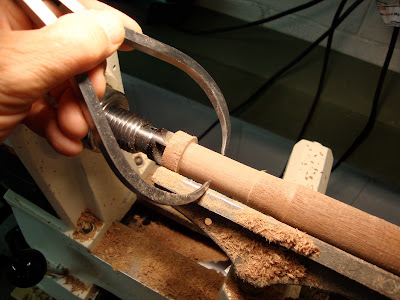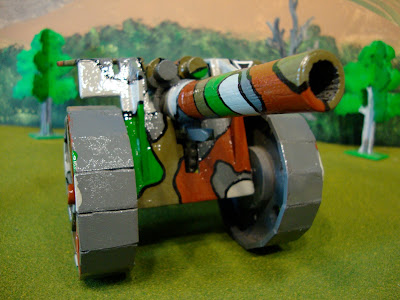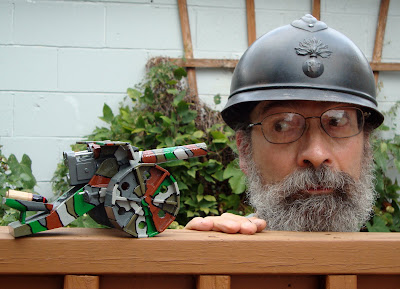I've always been a fan of artillery, especially the heavy guns used during the Great War. With all those rivets, gears, wheels, steel and brass, there's something positively steam-punk about the look.
Having recently acquired a beautiful and classic Britain's 4.7" naval gun, I decided to increase my artillery holdings while at the same time staying within my budget. Out I went to my shop - Victory Wood Working - to dig through the scrap pile for some odd pieces of mahogany, Armed with the wood, the time and the tools, now I had to find a likely candidate.
There is a dizzying array of available subjects, and I chose to cherry pick the more dramatic features of several guns and combine them into one fancifully generic cannon.




Every shop project starts with a drawing and this one was no exception. Using the journal book my sweetie got me for my birthday I sketched out plans that incorporated my favorite WWI gun features.
Identifying Clausewitz's "center of gravity" for the project was important, that one piece upon which the whole assembly would depend. That turned out to be the yoke which would support the barrel and the recuperator cylinders. The milling began at the drill press with measured holes (determined by the sizes of my available spade bits) drilled through a piece of mahogany.
From the drill press station the piece moved to first, the band and scroll saws to be roughed out and then to the belt sander where it became the yoke.
Hand sanding with fine files and sand paper sticks produced this finished piece:
I clamped another piece of mahogany stock into the wood lathe and started removing wood, being careful to measure a consistent diameter as I went along.
This became the barrel of the piece.
Like all sculpture, one simply removes all of the material that doesn't look like the thing which one is trying to sculpt. The grain on this mahogany required as much time sanding as chisel and scraper work.
Following a good deal of careful sanding, the finished barrel fit perfectly into the yoke.
Then it came time to build the carriage. I glued and clamped two pieces of mahogany to provide the right thickness for the carriage. I traced the outline onto the stock and, after drilling the hole for the trunnions, I returned to the band saw to release the carriage from the block of wood.
And it seemed pretty happy to get out of there.
Next I built the elevation gear which would appear so prominently beneath the recoil track of the barrel. These enormous toothed-gears are a distinctive feature of the big guns of the Big War.
The components in raw mahagony. The maple plywood is a pattern for what will become the wheels.
Building the breach block required as much hand work as power tools
Everything fit together nicely, though this is the point at which I started to rethink the asthetics of my recuperator cylinders.
Temporarily mounted on wheels, everything is looking pretty good, except for those cylinders. The look so...long.
I broke my mahogany habit long enough to build the gun shield out of maple plywood. I'm still not sure that this was the best choice, but onward I went, gluing and clamping.
Back to the lathe to turn two jolly, fat projectiles which fit in their mechanized (pretend, that is) loading tray. Yes, this is a large caliber gun.
Now on to the wheels. I didn't want to have to deal with spokes, and fortunately WWI was an era of a variety of spokeless steel wheels. I fit characteristic "duck boards" around the diameter and shaped reinforcing ribs on my disc sander. The masonite duck boards were the only instance of using hot glue rather than wood glue.
Wheels complete, and temporarilly mounted, it was time to glue and clamp the gun shield into place.
By this time, I made the decision to shorten the recuperator cylinders, and I'm so glad that I did.
At that point all the sub assemblies got a good coat of grey primer.
I also took a moment to simulate some rifling in the muzzle.
Then it was time to move out of the shop and into the sunshine to apply the "dazzle" camoflauge scheme to the piece. What a beautiful morning.
And "voila" as my beloved French say; my heavy gun is at the front and ready for action.
With the barrel returned to the "in battery" position, the loading tray is ready to be elevated and the next round rammed into the breech.
The Huns are menacing even in small scale.
Until next time, Soldier On!
Mannie































7 comments:
If you're going to play...PLAY!
Manifique!
It looks great! You are indeed a master craftsman.
I love your work, but you have way too much free time on your hands!
As a retired artilleryman, I like!
Sacrebleu! I think you've
painted yourself into a corner
is right lol...Very nice!
would you fancy a life swop for a few weeks,as yours looks to be very rewarding.
Mannie,
Your talent never ceases to amaze me!
Awesome!
Jeff
Post a Comment